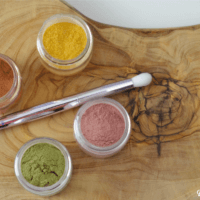Over the years I’ve come up with plenty of natural makeup options. While I’ve already shared some of my simple eye makeup recipes here, this article gives more details on how to make your own DIY natural eyeshadow in a variety of shades!
Make Your Own Natural Eyeshadow
These recipes use herbs, clay, and real food ingredients. You can also add some mica for a little shimmer if desired. There are lots of pigment options, but I stuck to a few of the most common ones. If you’re in the mood to experiment, then give one of these a try for some homemade eyeshadow.
Tip: Make sure everything is very finely ground.
- Purple/blue – freeze-dried blueberry powder
- Pink – freeze-dried raspberry powder, hibiscus powder, or beetroot powder.
- Green – spirulina or moringa powder
- Orange/yellow – turmeric powder
- Brown – cocoa powder
- White – kaolin clay
- Dusty rose – rose kaolin clay
- Light green – french green clay
Shimmery Mica
I add a little mica to products like lotion bars and tinted face moisturizer. Mica looks equally as good in eyeshadow. This mineral is naturally found in rocks and has a layer structure that catches the light and makes it sparkle. If you don’t have any on hand then it can easily be omitted. Mica doesn’t really add color on its own, just some sparkle.
Ultramarines are another common ingredient in eyeshadow products. Naturally derived ultramarine pigment is made from ground lapis lazuli and has been used for thousands of years. Natural ultramarines can have high levels of lead and other heavy metals due to their nature. Most cosmetics now use synthetic ultramarines derived from clay and sodium carbonate. Plants aren’t as vibrant as synthetic colorants, but I feel better about having them on my skin.
Why Skip Regular Eye Shadow?
I think by now you know the drill. Mainstream beauty care products are full of ingredients I’d rather avoid. Some of them also test on animals. The harsh chemicals in some eyeshadows can cause irritation, redness, itching, and flaking. Someone can use makeup multiple times or even for years only for it to then cause issues, according to allergist Purvi Parikh MD.
While it’s easy to reach for a brightly colored palette in the beauty aisle, it’s easy enough to make your own!
DIY Eyeshadow Safety
Spices like cinnamon and ginger may smell amazing, but they contain irritating essential oils. You’ll find cinnamon powder in these coconut flour apple cinnamon muffins and even this pumpkin spice face mask recipe. But I’m not using cinnamon in my eye shadow!
As much as we may try not to, it’s easy to touch our eyes or sweat and get eye makeup inside the eye. Our eyelids are the thinnest skin on the body at only .3-.8 mm thick and require special care. So while a pumpkin spice eyeshadow may look (and smell!) amazing, it’s not worth the risk of burning eyes.
We’re also not adding any oil or essential oils to the DIY eyeshadow recipe. While oil does make the powder stick to the skin better, it made the eyeshadow clumpy in my experiments. And not in a good way. The easiest option I’ve found is to swipe a light layer of a fast-absorbing carrier oil over the eyelid first. Then apply the eyeshadow powder. This method gives the eyeshadow some staying power without getting oily or clumpy.
I use a lot of essential oils in skincare products like deodorant and lotion, but they’re not so great for eye shadow. This coffee under eye cream uses a tiny amount of lavender essential oil, but it’s also not going on the eyelid itself. Essential oils in the eye can cause burning, redness, and general irritation.
What’s in a Natural Eyeshadow Recipe
Like most of my homemade makeup, it’s an art and a science. I often measure my makeup recipes in drops and pinches, but this DIY eyeshadow recipe is a little more precise. Feel free to play around with the colors though until you get the shade you want.
- Arrowroot powder adds a little slip and acts as a base for the pigments. Most of the herb powders on their own are a little too course to stay on by themselves. The arrowroot smooths things over and blends them together.
- Mica (as mentioned before) adds a little shimmer, but not much color. Feel free to skip it if you prefer.
- Clays are light and powdery and add some soft color. Like the arrowroot, they help the plant pigments blend better.
- Natural colorants like cocoa powder, turmeric, and beetroot are what make this DIY eyeshadow recipe colorful.
Where to Buy Natural Eye Shadow
If you don’t have the time to DIY, you can find healthy, natural eyeshadow options from Toups Organics here:
DIY Natural Eyeshadow Recipe
Materials
Dusty Rose Eyeshadow
- ¼ tsp arrowroot powder
- ½ tsp rose clay
Sea Green Eyeshadow
- ¾ tsp spirulina powder can sub moringa powder
- ¼ tsp arrowroot powder
Cocoa Shimmer Eyeshadow
- ½ tsp cocoa powder
- ¼ tsp arrowroot powder
- 1 pinch bronze mica powder optional
Gold Eyeshadow
- ¾ tsp turmeric powder
- ¼ tsp arrowroot powder
- 1 pinch bronze mica powder optional
Instructions
- Combine all the ingredients for your desired shade in a small container.
- Tightly cap the container and shake well to combine. Allow the powder to settle some before opening the lid.
- Apply a tiny drop of oil to the eyelid and massage in. Use a makeup brush to apply the eyeshadow colors as desired.
Notes
Which natural colors are your favorite for eyeshadow? Do you wear other homemade eye makeup? Leave us a comment and let us know!



Leave a Reply